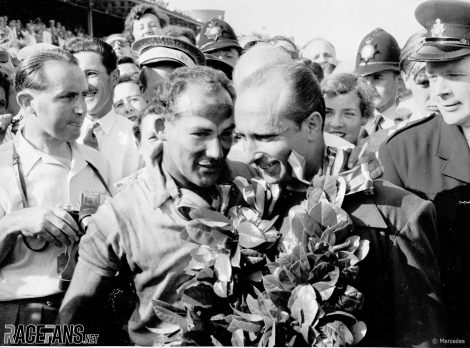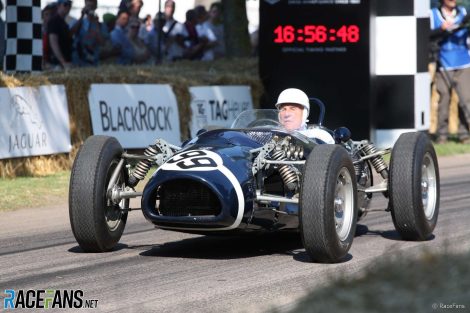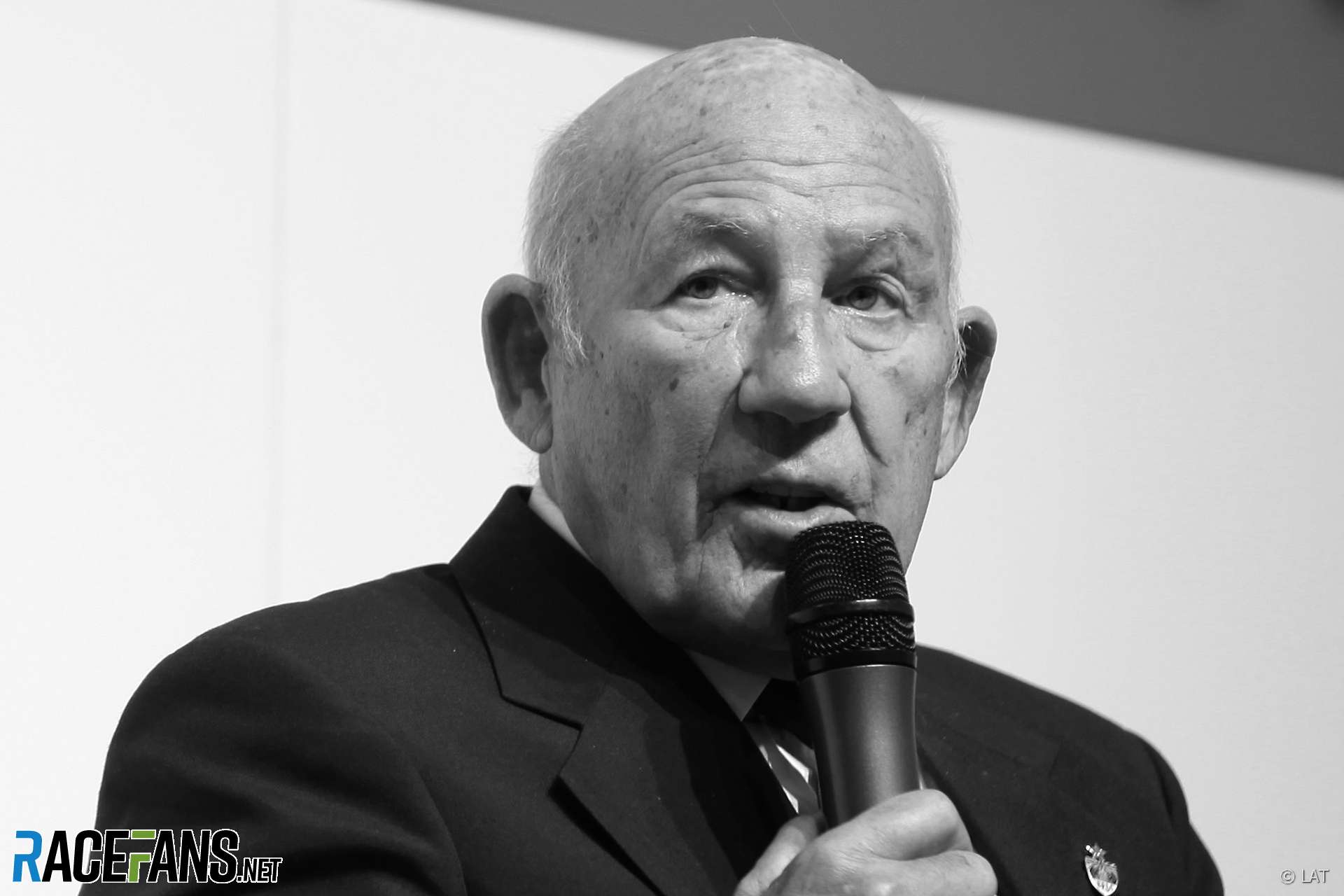Sir Stirling Moss, who has died at the age of 90, was far more than just ‘the greatest driver never to win the world championship’, the label most often applied to him.
At a time when the championship season amounted to just a handful of races in a busy motor racing calendar, Moss’s regular successes in almost any machinery he turned his hand to established him among his rivals and the motor racing world as the foremost talent of the time.Moss began racing in 1947 and quickly made a name for himself in sportscars, claiming victory in the 1950 Tourist Trophy on the punishing Dundrod course in a Jaguar XK120. The world championship began that year at Silverstone and Moss appeared in the 500cc support race, finishing second to Frank Aikens.
His first at appearance in a world championship event came at Bremgarten the following this year, the first of several starts in a range of different machines. Once he acquired a Maserati of his own in 1954, Moss immediately took third place at the formidable Spa-Francorchamps, and later in the year he joined the factory squad.

Following a terrible crash at Le Mans that year, when the Mercedes of Pierre Levegh was launched into the crowd, killing more than 80 people, the manufacturer withdrew from motor racing. Moss, who had won the gruelling Mille Miglia and Targa Florio sports car races for the team,
Moss returned to Maserati for 1956 where more wins followed but Fangio, now at Ferrari, took the title again. The following year Moss joined Vanwall, a promising new British outfit run by Tony Vandervell, and gave them their first win at Aintree after taking over team mate Tony Brooks’ machine. He won twice more with the team in Italy that year.
Advert | Become a RaceFans supporter and
A title shot looked like a realistic possibility in 1958 particularly as Fangio, who had by now beaten Moss to the title for three years running, retired from F1 early in the year. Victory in the season-opener (in a Rob Walker-run Cooper before returning to Vanwall) was the first of four wins for Moss in 10 races. But unreliability meant his only other finish was second place in France.

The death of Moss’s team mate Stewart Lewis-Evans in the same race prompted Vandervell to close his team. Moss reunited with Rob Walker and drove his privately-entered Cooper for much of the season, though he made two starts for the British Racing Partnership effort at mid-season, and despite two wins late in the year the title eluded him again.
Moss’s 1960 campaign was disrupted by a serious crash during practice at Spa, though he won twice more. The following year, after Walker’s switch to Lotus chassis, Moss produced two of his finest race-winning drives. He single-handedly saw off the Ferrari threat at Monaco, and scored a superbly-judged win on a damp Nurburgring Nordschleife.
Enzo Ferrari has pursued Moss earlier in his career. Seeing the Lotus beat his best drivers at Monaco gave him more food for thought, and for 1962 he resolved to finally get Moss in a prancing horse. Astoundingly, he was even prepared to allow Walker to run the cars for him.
Although Ferrari’s 1962 car subsequently proved much less competitive than their title-winning machines of the previous season, a Walker-run Moss Ferrari could have been a competitive proposition. Sadly, its potential was never realised, as a heavy crash during the Glover Trophy meeting at Goodwood in April left Moss with head injuries which ended his career.
Advert | Become a RaceFans supporter and

In enforced retirement, Moss worked on his business interests and remained close to the sport he loved. He became a regular at historic events, notably the Goodwood festivals, where new generations of motor sport fans discovered one of Britain’s most revered drivers.
An accident at his home in 2010, when Moss fell three storeys down a lift shaft and broke bones in his ankles and feet, hastened an end to his driving appearances. In 2016 he was suffered a chest infection while in Singapore, and two years later he announced an end to his public engagements.
Moss’s death following a further illness was confirmed by his wife, Lady Moss, early on April 12th, 2020.
Go ad-free for just £1 per month
>> Find out more and sign up
F1 history
- How you rated F1’s 12 sprint races so far – and why two outscored the grand prix
- Alonso set to become F1’s oldest driver for more than 50 years
- From ‘Flying Pig’ to Senna’s heroics: The short, incredible history of Toleman
- From farcical to fantastic: Formula 1’s 14 title-deciding Japanese races ranked
- Benched: The five other drivers who stood down for team mates in last 50 years





Dutchguy (@justarandomdutchguy)
12th April 2020, 16:00
R.I.P.
One of the last 1950s drivers gone. He will be missed
George (@feral)
12th April 2020, 16:54
I would just like to reflect how following F1 was in the late ’50s onward.
Live coverage was very limited and the fateful Goodwood race when Sterling had is racing career terminated was one of these. BBC would usually cover non championship races from Goodwood, Oulton Park and Aintree etc. with live clips of world championship European races., We could also catch highlights of every F1 championship race on cinema news round.
The most exciting information was getting your copy of Motorsport each month which would give you a lap by lap account of the latest GP. I would read these many times over and feel the excitement.
So many times these reports would reveal the death of yet another great driver.
I often feel that we now have such great daily coverage of F1 it has somehow contributed to losing the intrigue and magic.
This is a salute to all the great motor racing legends who lost their lives doing something they loved and emoted all F1 fans.
Urvaksh (@thedoctor03)
12th April 2020, 18:12
Thank you @feral. So grateful to have these accounts from fans like you.
Phylyp (@phylyp)
12th April 2020, 18:41
Thank you for the memories and the racing, Sir Stirling.
NS Biker (@rekibsn)
12th April 2020, 22:13
Best one I remember reading about Sir Stirling was his response to being asked, “How do you stay so young and active at your age.?”
Well he said, “I don’t drink, much, I don’t smoke and two out of three isn’t bad.”
JMDan (@danmar)
13th April 2020, 0:20
One less legend among us.